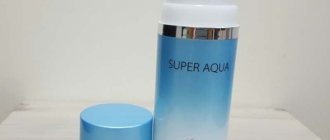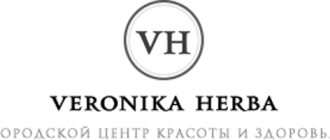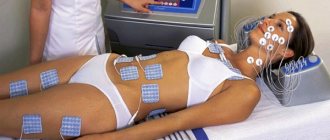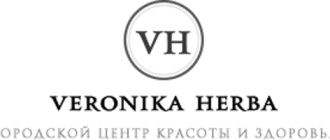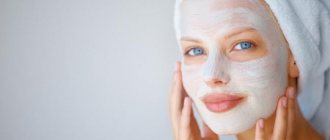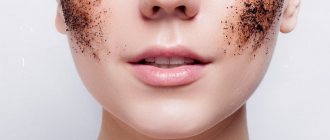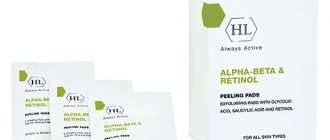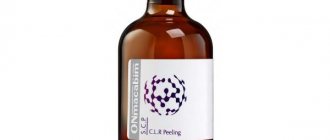From this article you will learn:
- Indications and contraindications for glycolic peeling
- 4 Possible Complications After Glycolic Peel
- 5 stages of glycolic peeling
Glycolic peeling is a superficial chemical procedure that uses a glycolic acid-based solution. This product is perfect for dehydrated and sensitive skin. After several sessions, the face is noticeably renewed and also restores its water balance.
According to experts and clients of beauty salons themselves, such peeling gives the skin freshness on the eve of important events, and does it better than many cosmetic procedures. However, there are also nuances here in the form of contraindications and possible negative consequences.
Indications and contraindications for glycolic peeling
For what problems is the procedure indicated:
- there are unwanted freckles and age spots;
- there is hyperkeratosis (the skin thickens due to the body getting rid of dead cells too slowly);
- there are signs of photoaging (to slow down or delay the process);
- the skin has become loose and less elastic;
- Acne breakouts occur frequently.
Exfoliation of dead cells with glycolic acid is so gentle that it can be used even in the presence of a number of skin diseases, such as eczema, atopic dermatitis, rosacea. Glycolic peeling has the ability to protect the skin from UV rays, so it is often recommended to do it before vacation to prepare the face for sunbathing. Glycolic peeling will also have obvious benefits after intense tanning - it helps activate the renewal processes of skin damaged by ultraviolet radiation.
Recommended articles on the topic:
- Ultrasonic facial peeling is a pleasant and beneficial procedure for your skin
- Redermalization of the skin: all the pros and cons
- Almond peeling for the face: features of the procedure
All this is due to the properties of glycolic acid, which is considered a natural photoprotector. But it is wrong to think that after such peeling there is no need to use sunscreen - the skin still needs them, so creams with SPF cannot be ignored. Glycolic peeling is an all-season procedure; it can be performed throughout the year.
Contraindications to the procedure are the same as for superficial peeling with alpha hydroxy acids (AHA) - lactic, glycolic, almond, tartaric, malic, kojic, phytic, citric:
- The body does not accept gluconolactone or other peeling components (there were manifestations of an intolerance reaction).
- There are skin diseases in the active phase (acne, hyperkeratosis, etc.).
- A viral infection (herpes, HPV) has worsened.
- The skin has unhealed wounds, abrasions, scratches and other damage.
- There are sunburns or a newly developing tan.
- The body temperature is elevated and there is a fever.
- State of pregnancy or breastfeeding.
Contraindications must be taken seriously and not ignored, otherwise the procedure may result in health problems.
Peeling gel with glycolic acid 10% Pleyana Glicolic Acid Gel Peel
Volume: 120 ml.
Description: gel peeling with glycolic acid 10% pH 3.5 is a peeling containing glycolic acid, the anti-aging properties of which were known about half a century ago.
Glycolic acid is found in sugar cane and green grapes. Glycolic acid rejuvenates the skin and minimizes hyperpigmentation. Rejuvenation of the epidermis is the main goal of glycolic peel therapy. Using a 10% glycolic peel allows you to avoid epidermolysis (flaking, which usually occurs after procedures of this kind) - it is a gentle peeling, but very effective. The upper layer of the epidermis is renewed, as well as the basement membrane and mesoderm, because Glycolic acid stimulates fibroblasts to actively produce collagen, elastin and glycosaminoglycans, resulting in increased skin turgor and elasticity, and significantly rejuvenated skin. 10% glycolic peeling is one of the most convenient and comfortable options for gentle peeling. Acting on collagen and elastin fibers, glycolic acid leads to their retraction (compression), which gives a good lifting effect. Thus, all layers of the skin are renewed. The glycolic peeling procedure is desirable and indicated for almost everyone with the aim of smoothing the skin texture, eliminating “sun wrinkles”, biostimulating and moisturizing the skin. It is especially effective and timely to perform a glycolic peeling procedure, in particular gentle glycolic peeling in the autumn-winter period, when the sun is not so active on the skin. Active ingredients: glycolic acid (10%), urea, aloe Barbados, echinacea extract, camellia, calendula, centella, lemon balm, hamamellis, tily, L-arginine, dihydroquercetin (flavocon).
Indications for the use of glycolic peeling:
- wrinkles
- scarring
- hyperkeratoses
- uneven skin texture
- skin dehydration
- seborrheic dermatitis
- superficial pigment spots
Directions for use: in the evening, apply the peeling gel to previously cleansed, moisturized skin, leave for 5-15 minutes and carefully rinse off the gel, avoiding contact with the eyes. Remove the remnants of the glycolic gel peeling with discs, then apply a night cream depending on your age-related skin characteristics.
Consumption of gel peeling with glycolic acid for 1 procedure (face) is 1.5-2 ml. One package (120 ml) - for 100 - 130 procedures (face). ph = 3.5
Many studies on the effects of glycolic acid on the skin have found that long-term use of glycolic acid for 3-6 months helps fade fine lines, reduce deeper wrinkles, and lighten pigmented areas of the skin. Cosmetics with glycolic acid, in particular gel peeling with glycolic acid "Plejana", can be used even at a young age.
Glycolic acid regulates keratinization (keratinization) of the epidermis, richly moisturizes, and has antioxidant and anti-inflammatory effects. Glycolic acid stimulates the synthesis of collagen and glycosaminoglycans, and is a conductor of other biologically active components into the deep layers of the skin. Contraindications to the use of glycolic peeling: herpes, exacerbation of acne, severe rosacea, increased skin sensitivity, the presence of tumors on the skin, recent skin injuries, individual intolerance to drugs, chronic dermatoses in the acute stage (eczema, demodicosis). Products with glycolic acid have no age restrictions and can be used even by young girls. Glycolic acid controls the process of keratinization of the epidermis, intensively moisturizes, has antioxidant and anti-inflammatory effects, stimulates the synthesis of collagen and glycosaminoglycans, and is a conductor of other biologically active components into the deep layers of the skin. Glycolic acid solution is a powerful antioxidant, prevents peroxidation processes in the skin, which allows peeling procedures to be carried out during active sun periods without fear of irritation and pigmentation. The glycolic peeling procedure is absolutely painless and does not require a subsequent rehabilitation process. Cosmetic effect of glycolic peeling: - stimulation and renewal of facial skin cells, - increasing skin elasticity, - reducing the depth of wrinkles, - masking skin defects, - evening out skin color, - moisturizing the skin, - cleansing the skin (destruction of excess sebum and dead cells).
Available: Lots
Carrying out at home
All of the drugs listed above are purchased not only by professionals, but also by amateurs who want to achieve good results on their own.
When carrying out the procedure at home, some nuances appear:
- for each skin type, it is preferable to select your own product with a certain chemical composition, which only a cosmetologist knows for sure;
- if the rules for applying and washing off the solution are not followed, complications develop that require medical supervision and selection of therapy;
- Phytic acid is forbidden to be used by everyone; there are contraindications, which the doctor is also aware of.
Buyanov Sergey Yurievich (Expert Doctor):
When using phytin pling at home, it is important to remember the 15-minute rule, and you should also keep in mind that the exposure should be extended gradually. For the first procedure, 3-5 minutes are enough, and no more.
If there is a large defect on the face, pronounced acne, or a scar, there is no need to try to get rid of it on your own, it is better to consult a cosmetologist.
It is important to remember that any experiments with skin can result in serious injury, deep burns, so it is better to entrust this matter to professionals with extensive experience.
Precautionary measures
Peeling with phytic acid has a minimal set of contraindications and does not cause complications. Before the procedure, it is necessary to do a skin test to determine possible hypersensitivity.
Contraindications
Phytin peeling is not recommended for everyone. It cannot be performed in the presence of pathologies such as:
- period of pregnancy and lactation;
- hyperglycemia - an increase in the concentration of glucose in the blood;
- papillomatosis – the growth of benign neoplasms against the background of a viral infection;
- re-infection;
- the presence of small scratches, abrasions, wounds and cracks on the face;
- growth of a malignant tumor;
- psoriasis is a pathology whose cause is not clear;
- functional failure of the heart, liver, kidneys in the stage of decompensation;
- herpetic infection;
- eczema.
Precisely because there are contraindications, before the procedure it is necessary to make an appointment with a specialist and undergo diagnostics.
Side effects
Phytin peeling is becoming increasingly popular precisely because, despite its high effectiveness, it does not cause undesirable consequences. The only thing that may occur is an individual allergic reaction in the form of redness, dermatitis or urticaria.
Chemical peels
Modern cosmetology offers women many ways to care for their skin.
One of the most effective is chemical peeling. In 2010, the Spanish company Sesderma offered the cosmeceutical market chemical peels based on nanotechnology to solve aesthetic and dermatological skin problems. Currently, there are more than a hundred different chemical peeling products based on glycolic and trichloroacetic acids on the global cosmetology market. The cost of chemical peeling at the Cellulite clinic is quite affordable.
In 2010, the Spanish company Sesderma offered the cosmeceutical market chemical peels based on nanotechnology to solve aesthetic and dermatological skin problems.
Sesderma is the first company to apply nanotechnology in the production of dermatological and cosmetic products. Sesderma has its own research center, which, using advances in the field of nanotechnology, has developed special nano-containers to protect active substances from destruction and target delivery to the deep layers of the skin.
MEDIDERMA peelings from Sesderma are intended for professional use in clinics and beauty salons. They solve the problems of skin aging, age spots, etc., giving the skin a fresh and well-groomed appearance. The main advantage of MEDIDERMA peels is that they are suitable for people with sensitive skin and high phototypes.
Types of MEDIDERMA peelings in the Cellulite clinic network
Ferulic peelings Ferulic peelings are superficial medium peelings. Their main purpose is to prevent aging and rejuvenate the skin.
- corrects and eliminates wrinkles, decreased skin tone
- accelerates the process of cellular renewal
- has a pronounced antibacterial, sebum-regulating and wound-healing effect
- protects skin from UV
- damage and free radicals
- has vascular strengthening and anti-inflammatory effects
- moisturizes, evens out complexion, eliminates pigmentation
- increases local immunity and enhances the protective properties of the skin.
Ferulic peeling is all-season, suitable for all skin types and phototypes, especially effective for women over 35 years old.
Almond peels Almond peels are superficial peels. They have a soft and gentle effect on the skin.
- the antimicrobial and anti-inflammatory properties of mandelic acid are explained by its structural similarity to macrolide antibiotics
- used during periods of active sun. The appearance of post-peeling hyperpigmentation is excluded
- mandelic acid has an anti-inflammatory effect. For these reasons, almond peeling is recommended as an alternative to mechanical and manual facial cleansing.
- stimulates the synthesis of its own collagen, elastin and other important substances in the intercellular space.
After peeling, the skin smoothes out, begins to “breathe”, pigment spots disappear, and the level of skin moisture is normalized.
Retinol peelings Retinol peeling RETISES CT is a superficial-medium peeling. The main and most important property of Retinol peeling is the STRONGEST ANTI-AGING EFFECT.
- retinol reduces the destruction of collagen fibers and stimulates the synthesis of neocollagen.
- retinol has a direct effect on all living skin cells, improving skin texture and color, stimulating epidermal regeneration.
- smoothes wrinkles, increasing the thickness of the dermal layer. Stimulates cellular regeneration and cellular renewal, activates dermal blood circulation, stimulates protein synthesis.
- Provides skin whitening and moisturizing
- reduces hypersecretion of the sebaceous glands.
Salicylic peels SALIPEEL MEDIDERMA salicylic peels are medium peels. Effective for inflamed and non-inflamed acne, post-acne, comedones, aging skin, fighting wrinkles, neck dyschromia, stretch marks, seborrheic dermatitis, psoriasis, keratosis, rosacea, melasma.
